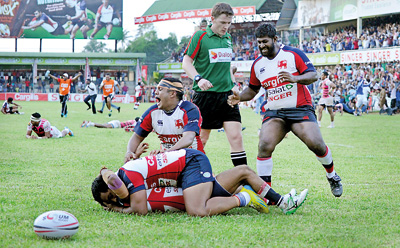Shallow back-line theories are sound, as long as the ball is delivered
View(s):At the end of a rugby season despite one game remaining Kandy SC are league champs. Looking over the shoulder; what lasting moments has the trail left behind? Did the club season provide great entertainment and or competition? Did the skills provide hope for standing up to the three top giants of Asia? Is there hope for taking the game to another level either as spectator entertainment or as a great competitor of Asia?
 The world is dividing people as those who do things – and people who get the credit. There is no major difference when you look at our common interest –Rugby. Whether on or out of the field there are people who do the work while others get the credit.
The world is dividing people as those who do things – and people who get the credit. There is no major difference when you look at our common interest –Rugby. Whether on or out of the field there are people who do the work while others get the credit.
In a match we focus on the back division as they are seen as doers –finishing what was started and or creating the entertainment. There is a tremendous load of work done by those who play up front – the forwards. But Then!!!
The men who take the credit are the backs from whom I ask have they taken the game forward. Whether at club or school hitting up front with the ball while moving is a must. What would you rate for what has handed as we look back.
Passing the ball while moving is what makes rugby more attacking whether you are at International club or schools rugby. Other than the occasional blitz what we see a standing and or slow delivered the pass which has no great threat to the opposition. As a consequence, the player receiving that pass attracts extra defenders, less space, but sometimes more time without benefit. In that situation the big passes more often ends up isolating runners.
This has to be coupled with the quality of handling and passing. For all the different moves that go into back-line play, the basic ability to hit the mark under pressure is an absolute necessity. Coupled with that skill is the ability to catch, to catch under pressure, and to catch and pass those are the fundamentals.
Now let us consider the two variables that go in to play. Should it be deep or shallow, – wide or close? The principal is that the back line should only be as deep as is needed to allow quality passing and handling while still moving forward as you pass.
Shallow back-line theories are sound, as long as the ball is delivered while the defence is being placed under real pressure. But this approach means it’s more difficult to get the ball wide.

Kandy SC have already won the League title with a match to go
Width is an even more interesting principle to consider as it will ensure – or at least encourage – quality handling. The talented back lines, standing wide increases the width, at least in theory. If you can stand wide, move forward as you pass and still deliver accurately, this is obviously the ideal pattern. To keep a wide line requires to consider the ability of players and will determine the width – that is, stand only as wide as you can. The report card of the season need to be marked and what we saw is either a line that was deep going nowhere with the intention being protected of close line where there were rapid passes seen dropped. When it was wide it was inaccurate passes that were dropped or went forward.
On a 65-metre-wide field, if the distance between the scrum-half and fly-half is 10m and you have a scrum 5m from the touchline, there is a full 50m left outside the fly-half. If the inside and outside centres are then separated by 4m each, that will leave your back trio – the two wingers and the full back (with more than 40m of width to play in. By contrast, standing 10m apart (English/All Black style) will leave only 30m of space out wide, with a consequent increased risk of poor passing. We watch a lot of NZ rugby and use the video from there but have we trained to achieve the success of being able to give and catch a good pass.
The Aussies and SA stand very wide; they have the skills to support that style. The English also stand pretty wide which causes opposition defenses to drift. For that reason their breaks are primarily made by short passing moves designed to catch out the drift defence, not by moving the ball around their opposition. Width is ultimately dictated by skills. Depth is only important from the point where you actually deliver your pass, not the depth from which you began. Once again, your team’s skills will dictate how close to the opposition a player can catch a pass.The paramount basics of back-line play are: Passing for a player and not to him, Not standing still to deliver a pass, The ability to catch and pass with ease Inside backs going to the line and delivering with pace to allow the most skillful runners on the outside time and space.
Mark a score on these lines and you be the judge on the nature and development of the game this season. Another issue of depth and width is on the management and spreading the game. Depth is what will have to be done with the higher line competition in mind. The skills and horning in skills with improvement of coaching and refereeing staff is an important factor. Width is about broad basing the game and having a wider market who not play but take the game to many so that there will be a wider audience. In Asia the game is spread in all parts of India and China and across to Nepal, Vietnam, Indonesia, Syria, Bangladesh etc. in this region. In Sri Lanka it is not when Royal plays Trinity or CR, Kandy, Havelock’s play. The two things in the spread are about quality and the wider base which will give you a market and numbers to choose from. The wider the game goes the better chances for sponsors.
* Vimal Perera is a former player, coach, referee and an IRB Accredited Referees’ Educator


